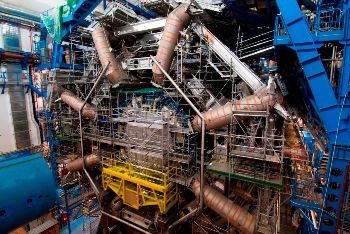NEWS
Louisiana Tech scientists celebrate Nobel Prize for Higgs discovery
Faculty from Louisiana Tech University’s College of Engineering and Science are celebrating the Royal Swedish Academy of Sciences’ awarding of the Nobel Prize in physics to theorists Peter Higgs and Francois Englert for their work developing the theory of what is now known as the Higgs field.
A team of physicists from Louisiana Tech, along with scientists from around the country, played a significant role in advancing the theory, which gives elementary particles mass, and in discovering the particle that proves the existence of the Higgs field, the Higgs boson.

Louisiana Tech faculty, students worked on the ATLAS experiment at CERN, which looks for general particle physics events on the LHC – Photo courtesy of CERN.
“While I had hoped that the experiments themselves would win the award, it is still exciting to be mentioned in the Nobel citation,” says Dr. Lee Sawyer, director of physics and chemistry at Louisiana Tech and one of the faculty scientists from Tech who have been working on the project. “The quest to discover the Higgs boson and the source of particle masses was a 50-year mission that began with Englert, Higgs and the late Robert Brout, and culminated with the measurements made by our experiment, ATLAS, and our colleagues, CMS, last year at the Large Hadron Collider in Geneva, Switzerland.”
Sawyer and his team, which included Professors Zeno Greenwood and Markus Wobsich, postdoctoral researchers Dr. Matthew Tamsett and Dr. Catrin Bernius, and students Ram Dhullipudi, Arirvan Sircar, Rajiv Subramaniam, Alex Johnson, David Palma and Andrew Touchet, had a substantial role in the discovery and all worked in a number of areas on the ATLAS experiment. Their contributions included verifying the quality of the data collected for the experiment and designing and maintaining the software that selects the collision events to record.
“This Nobel Prize announcement is exciting, particularly for our physics faculty who have played a significant role in the experiments that confirmed the discovery of the Higgs boson,” said Dr. Hisham Hegab, interim dean of Louisiana Tech’s College of Engineering and Science. “They have been active collaborators on the ATLAS detector project for several years and were made a full member institution by CERN this past year, becoming the only university in Louisiana with this distinction. Our College is fortunate to have faculty that are so closely connected to cutting-edge science.”
In the 1960s, Higgs and Englert, along with other theorists such as Robert Brout, Tom Kibble and Americans Carl Hagen and Gerald Guralnik, published papers introducing key concepts in the theory of the Higgs field. In 2012, scientists on the international ATLAS and CMS experiments, performed at the Large Hadron Collider (LHC) at CERN laboratory in Europe, confirmed this theory when they announced the discovery of the Higgs boson.
Nearly 2,000 physicists from 89 U.S. universities and seven U.S. Department of Energy laboratories participated in the ATLAS and CMS experiments, making up about 23 percent of the ATLAS collaboration and 33 percent of CMS at the time of the Higgs discovery.
Brookhaven National Laboratory serves as the U.S. hub for the ATLAS experiment, and Fermi National Accelerator Laboratory serves as the U.S. hub for the CMS experiment. U.S. scientists provided a significant portion of the intellectual leadership on Higgs analysis teams for both experiments.
“It is an honor that the Nobel Committee recognized these theorists for their role in predicting what is one of the biggest discoveries in particle physics in the last few decades,” said Fermilab Director Nigel Lockyer. “I congratulate the whole particle physics community for this achievement.”
The discovery of the Higgs boson at CERN was the culmination of decades of effort by physicists and engineers around the world, at the LHC but also at other accelerators such as the Tevatron accelerator, located at Fermilab, and the Large Electron Positron accelerator, which once inhabited the tunnel where the LHC resides. Work by scientists at the Tevatron and LEP developed search techniques and eliminated a significant fraction of the space in which the Higgs boson could hide. Written by Catherine Fraser – cfraser@latech.edu